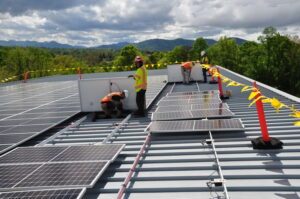Earlier this fall, I attended the switch-flipping ceremony for the new solar array at Isaac Dickson Elementary School. Consisting of 300 kilowatts of solar photovoltaic panels, the project was six years in the making, and is estimated to save the school more than $30,000 a year in energy bills–money that can be put back into school programming.

Attending the official switch-flipping ceremony brought things full circle for me for several reasons. As a board member of the Green Built Alliance, I was happy to see one of our flagship programs, Appalachian Offsets, make this possible. Yet the event had personal significance, as my husband, an Asheville native, attended Issac Dickson as a child, and I was able to bring our 11 month-old-son to see the switch flipping at the same school his father attended. Back when I was in elementary school, I was once given an assignment to create a design for how to make our school better. Budding environmentalist that I was, I proceeded to draw school covered with skylights and solar panels. I remember the teacher said that was neat, but, probably impractically expensive–yet here today, I got to see that idea realized for a real elementary school.
This project comes full circle for my own company, Deltec Homes, because it was funded through the Appalachian Offsets program, to which we have been a contributor for several years. Appalachian Offsets is a carbon-offsetting program: individuals or businesses can use the tools on the program’s website to calculate the environmental impact, in terms of tons of carbon dioxide emitted into the atmosphere, of their various activities. They can then purchase an offset to counteract those emissions, and those offsets deliver funding to energy efficiency or solar projects in the community that can deliver these emissions reductions. The Appalachian Offsets program has been around since 2009, and it has funded numerous other solar energy or energy efficiency improvements for non-profits, schools, churches, or low income housing communities in Western North Carolina. Nationally, as well as internationally, offset markets are growing as a way for individual and corporate citizens to make contributions to fighting climate change.
Every year since 2018, Deltec Homes has tallied up the miles traveled within the continental U.S. by our homes packages as they were shipped to our customer’s job-sites, and used the Appalachian Offsets calculator to estimate the equivalent CO2 emissions. We then purchased offsets for those emissions, helping, along with more than 100 other businesses and individuals, to raise the funding to make the Isaac Dickson solar array happen.
Some people might ask, wait a minute, isn’t a offset just a way to pay to keep polluting as usual? Shouldn’t entities hoping to reduce their carbon footprint commit to reducing energy use to begin with? And while offsets are growing in popularity, so are criticisms of offset programs’ abilities to actually deliver what they promise. Surely, we can’t all just offset our way out of the climate challenges we face?
I would argue that the answer is not “either, or” but “yes, and.” Offsetting is one tool, a free-market mechanism to deliver energy savings and renewable energy to our community at large as quickly as possible. While it isn’t sustainable in the long run for a company or individual to eliminate their entire carbon footprint forever through offsets alone, nor is it technologically or economically feasible for most entities to live in this society and totally eliminate their carbon footprint, either. We still use energy for business, personal matters, food, transportation. We should take every step to reduce the impact of that energy through all means: investment in energy efficiency or renewable energy where feasible, policies (whether personal, or organizational) to facilitate more conscious consumption, advocating for greener sources of fuel for the electric and transportation systems we depend upon…and also giving back to the community where and when we can. Think of it less like an “indulgence” and more like a charitable contribution to your community to fund the change you want to see in the world. Plus, using a tool to calculate your carbon footprint can help you discover the most impactful places where you can make a difference in reducing it on the front end.
On the effectiveness and transparency end, it comes back to local solutions to global problems. While some offsetting programs promise to avert cutting down a tree in Brazil, or deliver a cleaner burning stove in Kenya, I can walk down the street and see the projects funded by Appalachian Offsets in my own community, and to me, that has clear transparency. Any involvement with a program aiming to make society better involves research to understand how it works, and checking wither it aligns with your values and goals. To me, all of these potential carbon offsetting projects could be important, and we should continue to monitor the space and participate in creating systems to monitor and verify what offsets work and what don’t–but participating is still the first step.
Appalachian Offsets is not just for businesses. Individuals can contribute as well. Last year, I decided to use it to calculate and offset my family’s carbon footprint as well, and I know several other GBA board members did as well. Even calculating your carbon footprint can help you see a useful way to get a picture of the impact of what you do, and the impact of any potential reductions you may be motivated to make.

